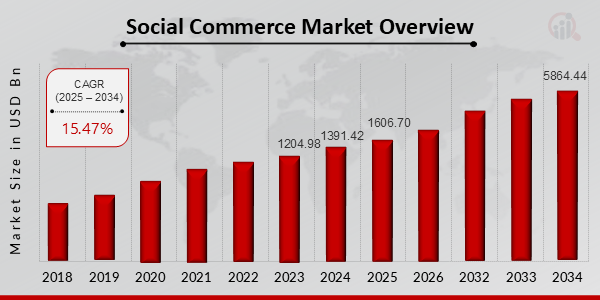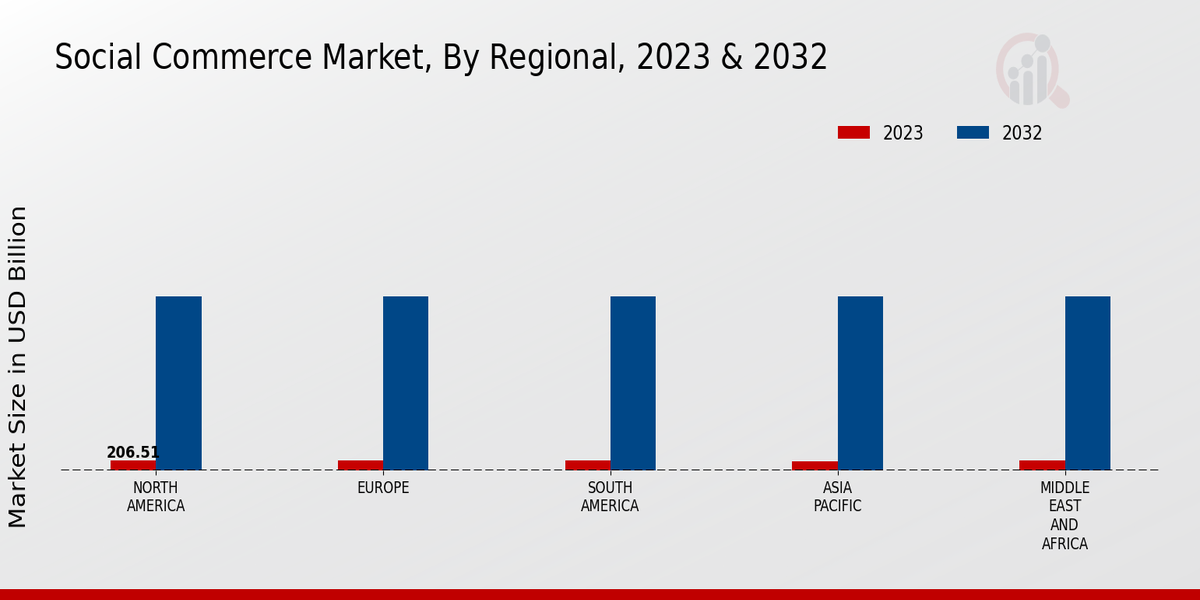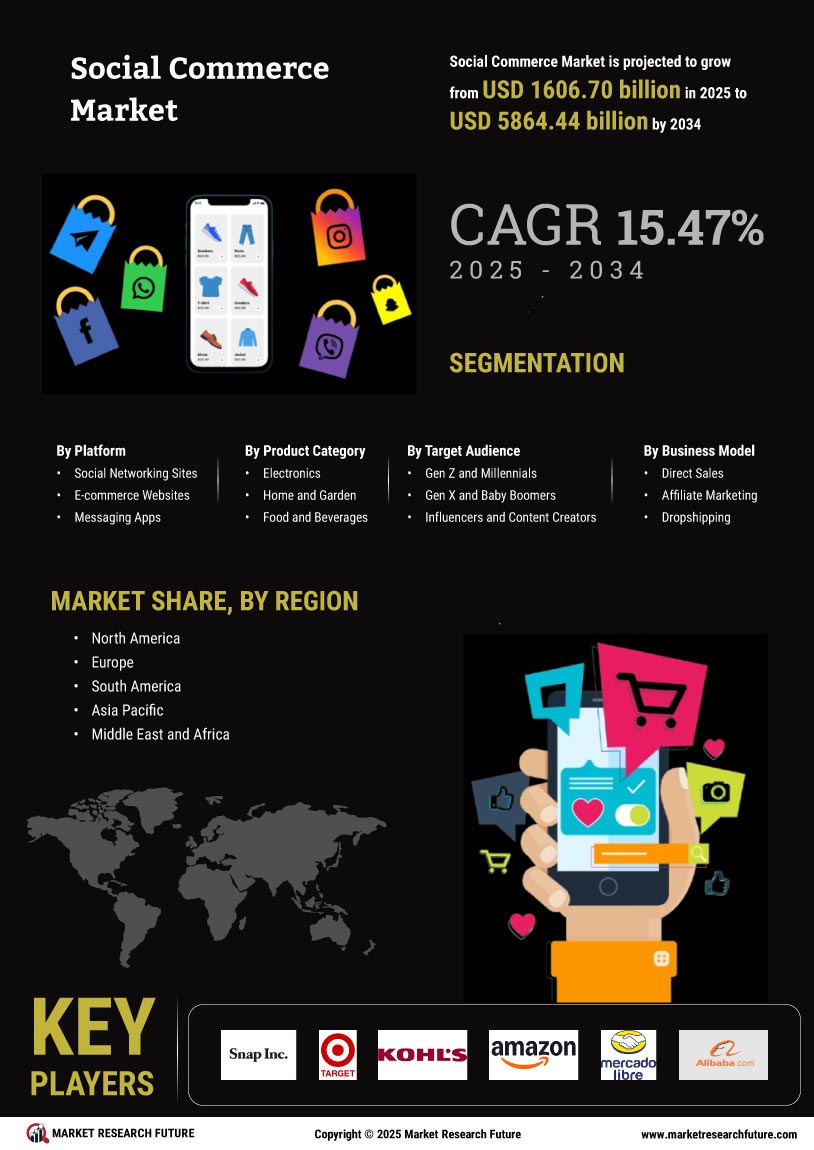Social Commerce Market Overview
Social Commerce Market is projected to grow from USD 1606.70 billion in 2025 to USD 5864.44 billion by 2034, exhibiting a compound annual growth rate (CAGR) of 15.47% during the forecast period (2025 - 2034). Additionally, the market size for Social Commerce Market was valued at USD 1391.42 billion in 2024.
Key Social Commerce Market Trends Highlighted
Crucial market drivers of social commerce include the increasing popularity of social media platforms, the growing adoption of smartphones, and the rising demand for convenience and personalized shopping experiences. Moreover, advancements in technology, such as augmented reality and virtual try-on features, are enhancing the overall customer experience. Key opportunities in the social commerce market lie in the expansion of emerging markets, the integration of social media platforms with other e-commerce channels, and the development of influencer marketing strategies. The growing trend towards live streaming commerce and the increasing use of social media for customer service and support further present significant opportunities for players in this market. Recent trends in social commerce include the rise of social shopping communities, where users can connect with others who share similar interests and make purchases based on recommendations. Additionally, the integration of artificial intelligence and machine learning algorithms is personalizing the shopping experience and driving conversions. The emerging trend of social commerce marketplaces, which combine social media features with e-commerce functionality, is also gaining traction, offering a seamless shopping experience for consumers.
Figure1: Social Commerce Market, 2025 - 2034

Source: Primary Research, Secondary Research, MRFR Database and Analyst Review
Social Commerce Market Drivers
Growing Popularity of Social Media Platforms
Social media platforms are vast in their connectivity with people. We use them so that we can maintain interaction with our loved ones and exchange thoughts to keep people updated on our concepts. Social media applications also help in introducing us to newer products and services. Apart from all of these, the reason that social media platforms are contributing to the increasing market share for this particular segment is the growing popularity of these platforms. More and more people are using social media, and businesses are now identifying the potential of these platforms to reach custom engagement. This factor contributes crucially to the growing social commerce market because businesses are utilizing these platforms to promote and sell their products.
Increasing Adoption of Mobile Devices
Another key driver of the growth of the Social Commerce Market Industry is the increasing adoption of mobile devices. Many people now use mobile devices as their primary way of accessing the internet. This is making it easier for them to shop online, and the development of mobile-friendly social commerce platforms is allowing businesses to sell their products and services through social media more easily than ever. As a result, a growing number of people are using social media to make purchases.
Rising Popularity of Live Streaming
The popularity of live streaming is increasing on social media platforms, which can create new opportunities for businesses to promote their products or services. The use of live streaming can help businesses introduce their products in a more personal and interactive context, which can potentially increase sales. For instance, Facebook allows users to broadcast live videos from their phones or computers. In addition, Periscope – a live video platform – is an application that can be used on Twitter to broadcast live videos.
Social Commerce Market Segment Insights
Social Commerce Market Platform Insights
The Social Commerce Market is segmented by Platform into Social Networking Sites, E-commerce Websites, and Messaging Apps. Among the three segments, Social Networking Sites held the largest market share in 2023, and this segment is expected to continue to dominate the market throughout the forecast period. The growth of this segment can be attributed to the increasing popularity of social media platforms such as Facebook, Instagram, and Twitter, among others. These platforms allow users to connect with friends and family, share content, and make purchases, which is expected to drive the growth of the segment.
Additionally, the increasing adoption of advanced technology by social media companies is expected to further drive the growth of the segment. The E-commerce Websites segment is expected to witness the fastest growth during the forecast period. This growth can be attributed to the increasing adoption of e-commerce platforms such as Amazon, Flipkart, Alibaba, among others. These platforms offer a wide range of products and services, which is expected to drive the growth of the segment. Moreover, the increasing popularity of mobile commerce is expected to further drive the growth of the segment.
The Messaging Apps segment is also expected to witness significant growth during the forecast period. The growth of this segment can be attributed to the increasing popularity of messaging apps such as WhatsApp, WeChat, and Telegram, among others. These apps allow users to send messages, make calls, and share content, among other things. The growth of the market can be attributed to the increasing popularity of social media, e-commerce, and messaging apps, among others, and the increasing adoption of AI-powered technologies.
Figure 2: Social Commerce Market, By Platform, 2025 & 2034

Source: Primary Research, Secondary Research, MRFR Database and Analyst Review
Social Commerce Market Product Category Insights
The Social Commerce Market is segmented by product category into Fashion and Accessories, Electronics, Home and Garden, Beauty and Personal Care, and Food and Beverages. Among these segments, Fashion and Accessories held the largest market share in 2023, accounting for over 35% of the Social Commerce Market revenue. This dominance is attributed to the increasing popularity of online shopping for apparel, footwear, and accessories, driven by factors such as convenience, wide selection, and competitive pricing. The Electronics segment is expected to witness significant growth during the forecast period, with a CAGR of over 17%, owing to the rising demand for smartphones, laptops, and other electronic devices. Home and Garden, Beauty and Personal Care, and Food and Beverages are other key segments that contribute to the overall Social Commerce Market growth. These segments are expected to benefit from the growing trend of online grocery shopping, home décor purchases, and the increasing popularity of social media platforms for product discovery and recommendations.
Social Commerce Market Target Audience Insights
Gen Z and Millennials, Gen X and Baby Boomers, Influencers and Content Creators, Small and Medium Businesses, and Online Shoppers are the key target audiences for the Social Commerce Market. Gen Z and Millennials are the most active social media users, and they are driving the growth of social commerce. They are more likely to purchase products and services through social media platforms than any other generation. Gen X and Baby Boomers are also active social media users, but they are more likely to use social media for staying connected with friends and family. Influencers and Content Creators are a powerful force in social commerce. They have a large following of engaged followers, and they can influence their followers' purchasing decisions. Small and Medium Businesses are increasingly using social media to reach new customers and grow their businesses. Online Shoppers are the target audience for all social commerce businesses. They are looking for convenient and easy ways to purchase products and services online.
Social Commerce Market Business Model Insights
The Social Commerce Market segmentation by Business Model includes Direct Sales, Affiliate Marketing, Dropshipping, White Labeling, and Social Selling. Direct Sales involves selling products or services directly to consumers through social media platforms, contributing significantly to the market's revenue. Affiliate Marketing allows influencers or content creators to earn commissions by promoting products or services on their social media channels. Dropshipping enables businesses to sell products online without holding inventory, as orders are fulfilled by a third-party supplier. White Labeling allows businesses to sell products under their own brand name, while Social Selling involves leveraging social media platforms to build relationships and drive sales. The market growth is attributed to the increasing popularity of social media, the rise of mobile commerce, and the growing consumer preference for personalized shopping experiences.
Social Commerce Market Value Proposition Insights
Value Proposition The value proposition of social commerce lies in its unique advantages over traditional e-commerce channels. By leveraging the power of social media platforms, social commerce offers: Convenience and Accessibility: Social commerce allows consumers to shop seamlessly within their existing social media apps, eliminating the need for separate shopping platforms. With over 4.62 billion active social media users ly in 2023, businesses have access to a massive potential customer base. Social Proof and Influencer Marketing: Social media provides a platform for customer reviews, testimonials, and influencer endorsements. This social proof builds trust and encourages purchases, with 92% of consumers trusting recommendations from friends and family. Personalized Recommendations: Social commerce platforms utilize algorithms to track user behavior and preferences. This data enables targeted product recommendations, increasing conversion rates by up to 30%. Community and Engagement: Social commerce fosters a sense of community, allowing brands to engage with customers directly. Live stream shopping, interactive polls, and user-generated content create a more engaging and immersive shopping experience. Cost-Effectiveness: Compared to traditional e-commerce models, social commerce requires lower setup and operational costs. Businesses can leverage existing social media presence, reducing marketing and advertising expenses.
Social Commerce Market Regional Insights
The Social Commerce Market is segmented into North America, Europe, APAC, South America, and MEA. Among these regions, North America is expected to hold the largest market share in 2023, followed by Europe and APAC. The growth in North America is attributed to high internet penetration, increasing adoption of social media platforms, and growing consumer spending on online shopping. Europe is also expected to witness significant growth, driven by the increasing popularity of social media shopping and the presence of a large number of social media users. The APAC region is anticipated to be the fastest-growing market due to the rising middle class, increasing smartphone penetration, and improving internet connectivity. South America and MEA are expected to contribute modestly to the overall market growth.
Figure 3: Social Commerce Market, By Regional, 2025 & 2034

Source: Primary Research, Secondary Research, MRFR Database and Analyst Review
Social Commerce Market Key Players And Competitive Insights
The major players in the Social Commerce Market industry are investing heavily in their research and development activities to enhance the user experience with additional unique features and better usability. The Social Commerce Market industry is competitive, with major players present in the marketplace. The Social Commerce Market industry is driven by the increasing adoption of social media platforms and the trend of increasing online shopping. Key players are developing strong interests in their product offerings, such as forming partnerships. Developing strong marketing strategies and a wide customer base, being ahead of the market trend, and developing unique e-commerce platforms will also influence the growth of this industry. Additional features that meet customer needs will attract more users.
The main competitor operating in this industry is Facebook, which has also adopted social commerce features in its platform. Facebook has developed a Marketplace in which users can create accounts and post items that sell to customers. Facebook also offers business development pages and features for product marketing and associated functionalities. Facebook, being one of the most used social media platforms ly, is an attractive player with a broad user platform and a wide array of other related business and social activity features. Another major competitor in the same industry is Instagram, which also operates a social commerce market feature in its business. Instagram also offers shopping posts and stories, as the platform features pictures and colorful graphics. Viewers tend to be attracted to viewing and using its platform; hence, it’s a major social commerce market player. The third competitor, TikTok, is a growing internet-based platform with unique features. The TikTok platform offers shopping features and providers to develop short renewal period advert videos for its users. The maximal number of users and high activity rates are good indicators for the growth of this player within these industries.
Key Companies in the Social Commerce Market Include
Social Commerce Market Industry Developments
The social commerce market is projected to witness substantial growth from 2024 to 2032. Recent developments include the integration of social media platforms with e-commerce marketplaces, enabling seamless shopping experiences for consumers. Key players are investing in personalized recommendations and influencer marketing to drive engagement and sales. Emerging trends such as live stream shopping and social commerce-focused platforms are gaining traction, particularly in regions like China and Southeast Asia. The COVID-19 pandemic accelerated the adoption of social commerce as consumers turned to online shopping for essential and non-essential goods. This trend is expected to continue post-pandemic, with social commerce becoming an increasingly important channel for businesses to reach target audiences and drive revenue growth.
Social Commerce Market Segmentation Insights
Social Commerce Market Platform Outlook
- Social Networking Sites
- E-commerce Websites
- Messaging Apps
Social Commerce Market Product Category Outlook
- Fashion and Accessories
- Electronics
- Home and Garden
- Beauty and Personal Care
- Food and Beverages
Social Commerce Market Target Audience Outlook
- Gen Z and Millennials
- Gen X and Baby Boomers
- Influencers and Content Creators
- Small and Medium Businesses
- Online Shoppers
Social Commerce Market Business Model Outlook
- Direct Sales
- Affiliate Marketing
- Dropshipping
- White Labeling
- Social Selling
Social Commerce Market Value Proposition Outlook
- Convenience and Accessibility
- Social Proof and Influencer Marketing
- Personalized Recommendations
- Community and Engagement
- Cost-Effectiveness
Social Commerce Market Regional Outlook
- North America
- Europe
- South America
- Asia Pacific
- Middle East and Africa
|
Report Attribute/Metric
|
Details
|
|
Market Size 2024
|
1391.42 (USD Billion)
|
|
Market Size 2025
|
1606.701391.42 (USD Billion)
|
|
Market Size 2034
|
5864.44 (USD Billion)
|
|
Compound Annual Growth Rate (CAGR)
|
15.47% (2025 - 2034)
|
|
Report Coverage
|
Revenue Forecast, Competitive Landscape, Growth Factors, and Trends
|
|
Base Year
|
2024
|
|
Market Forecast Period
|
2025 - 2034
|
|
Historical Data
|
2019 - 2023
|
|
Market Forecast Units
|
USD Billion
|
| Key Companies Profiled |
Snap Inc., Target Corporation, Kohl's Corporation, Amazon.com, Inc., MercadoLibre, Inc., Alibaba Group Holding Limited, Pinduoduo Inc., Pinterest, Inc., Meituan, JD.com, Inc., The Estée Lauder Companies Inc., TikTok, Shopify Inc., Walmart Inc., Meta Platforms, Inc. |
| Segments Covered |
Platform, Product Category, Target Audience, Business Model, Value Proposition, Regional |
| Key Market Opportunities |
Influencer MarketingLive Stream ShoppingPersonalized RecommendationsIntegration with Social Media PlatformsCrossBorder Expansion |
| Key Market Dynamics |
Rising smartphone penetrationGrowing popularity of social mediaIncreasing disposable incomeChanging consumer behavioursEmergence of new technologies |
| Countries Covered |
North America, Europe, APAC, South America, MEA |
Frequently Asked Questions (FAQ) :
The social commerce market is expected to reach a valuation of USD 5864.44 billion by 2034, exhibiting a CAGR of 15.47% during the forecast period (2025-2034).
The Asia-Pacific region is anticipated to dominate the social commerce market, owing to the increasing adoption of social media platforms and the growing number of internet users in the region.
Social commerce finds applications in various industries, including fashion and apparel, beauty and personal care, electronics, home décor, and travel.
Some of the prominent players in the social commerce market include Meta (Facebook), TikTok, Instagram, Pinterest, and Amazon.
Factors such as the increasing popularity of social media platforms, the growing adoption of mobile devices, and the convenience of online shopping contribute to the growth of the social commerce market.
Challenges faced by the social commerce market include concerns related to data privacy and security, the need for effective logistics and fulfillment, and competition from traditional e-commerce channels.
The social commerce market is projected to grow at a CAGR of 15.47% from 2025 to 2034.
Emerging trends in the social commerce market include the integration of artificial intelligence (AI), the rise of livestream shopping, and the adoption of augmented reality (AR) and virtual reality (VR) technologies.
Businesses can leverage the social commerce market to expand their customer base, increase brand awareness, and drive sales through social media platforms.
Key strategies adopted by players in the social commerce market include partnerships with social media platforms, investments in technology and innovation, and the development of user-friendly and engaging social commerce experiences.

















